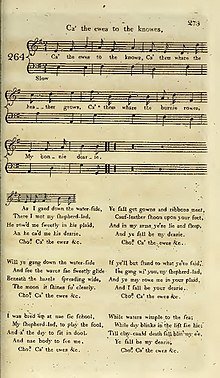Ca' the yowes
| "Ca' the yowes to the knowes" | |
|---|---|
 Score for "Ca' the Yowes" from the Scots Musical Museum, Volume III (1790) | |
| Song | |
| Language | Scots |
| Written | 1794 |
| Lyricist(s) | Isabel Pagan/Robert Burns |


"Ca' the yowes to the knowes" ("Drive the ewes to the hills") is a Scottish folk song collected by Robert Burns from 1794. Although sometimes attributed to Burns himself, the seven-stanza original poem is thought to be the work of Ayrshire poet Isabel Pagan, a contemporary of Burns. The poem was partially revised by Burns, and he added an eighth stanza. Burns later re-wrote the poem on a solitary stroll in the country, and this second version consists of six stanzas.[1][2][3] It is possible that Burns was not aware that Pagan was the original author, only noting that "this song is in the true Scottish taste, yet I do not know that either air or words were ever in print before."[4]
The original text is a pastoral love poem spoken from the point of view of a shepherdess herding her ewes ("yowes"), who has a romantic meeting with a shepherd lad. Burns's revised version is less explicit about the identity of the narrator, but follows a similar theme of love amid the beauty of nature. Both versions include the refrain, "Ca' the yowes to the knowes".
Text
[edit]| Original version (Pagan, ed. Burns) | English Translation | Second version (Burns) | English Translation |
|---|---|---|---|
| Refrain: Ca' the yowes to the knowes, |
Refrain: |
Refrain: |
Refrain: |
|
As I gaed down the water-side, |
As I went down the water-side |
Hark the mavis' e'ening sang, |
Hark, the song-thrush's evening song, |
|
Will ye gang down the water-side, |
Will you go down to the water-side, |
We'll gae down by Clouden side, |
We'll go down by the side of Cluden Water[Note 1] |
|
Ye sall get gowns and ribbons meet, |
You shall get suitable gowns and ribbons, |
Yonder Clouden's silent towers[Note 2] |
Yonder Cluden's silent towers, |
|
If ye'll but stand to what ye've said, |
If you will but stand to what you have said, |
Ghaist nor bogle shalt thou fear, |
Ghost nor hobgoblin shall you fear - |
|
While waters wimple to the sea, |
While waters flow to the sea, |
Fair and lovely as thou art, |
Fair and lovely as you are, |
- ^ a b c The Clouden refers to Cluden Water, a tributary of the River Nith in Ayrshire
- ^ Clouden's silent towers may refer to the ruins of Lincluden Abbey
Musical performances
[edit]
The song was made widely known in recordings by Kathleen Ferrier of an arrangement by Maurice Jacobson, composer, accompanist and chairman of the music publisher Curwen. These included in recitals given by Ferrier and Bruno Walter at the Edinburgh Festival of 1952.
In 1922, the English composer and scholar of folk music Ralph Vaughan Williams wrote a choral setting of "Ca' the yowes" for tenor solo and SATB chorus. Benjamin Britten also wrote an arrangement of the song in 1951 for solo voice and piano.[6][7][8] This version was later covered by artists like Shirley Collins and House and Land.[9]
In 2016 a version of the song was composed by Stephen Baysted for the Project CARS videogame, which has some levels taking place in Scotland.[10] The vocals were performed by Susan Legg.
American musician Joanna Newsom is also known to have performed this song during tours in the early 2000s. Her version is faithful to Pagan's original version though switches between Pagan's Scottish dialect and contemporary English. [11]
References
[edit]- ^ Whitelaw, Alexander (1844). The book of Scottish song, collected and illustr. with hist. and critical notices by A. Whitelaw. p. 466. Retrieved 22 January 2018.
- ^ The Illustrated book of Scottish songs: from the sixteenth to the nineteenth century. N. Cooke. 1854. pp. 101–2. Retrieved 22 January 2018.
Ca' the yowes.
- ^ Thomas Humphry Ward, M. Arnold The English Poets: Selections with Critical Introductions 1881 "The same mistake of ascribing popular songs to remote antiquity was made in the case of Ca the Yowes to"
- ^ Eyre-Todd, George (1896). Scottish Poetry of the Eighteenth Century. Taylor & Francis. p. 36. Retrieved 22 January 2018.
- ^ "Princess Anne unveils Burns sculpture in Dumfries". ITV News. Retrieved 22 January 2018.
- ^ "Ralph Vaughan Williams". Robert Burns choral settings. 25 February 2014. Retrieved 22 January 2018.
- ^ The American Record Guide Page 579 Peter Hugh Reed - 1962 "Ca' The Yowes" (also harmonized for solo and chorus by Vaughan Williams) appears here with Britten's flowing contrapuntal line mixed with broken chords....
- ^ "Ca' the yowes". brittensongs.org. Retrieved 22 January 2018.
- ^ Hughes, Rob (August 2, 2019). "House And Land – Across The Field". Uncut. Archived from the original on August 7, 2019. Retrieved August 7, 2019.
- ^ Project Cars OST: Ca' The Yowes, 29 April 2016, retrieved 2024-01-16
- ^ "Joanna Newsom - Ca' the yowes (11.16.06)". YouTube. 14 January 2009.
External links
[edit]- Text of Burns's second version: "Ca' the Yowes to the Knowes by Robert Burns". Poetry Foundation. 21 January 2018. Retrieved 22 January 2018.

